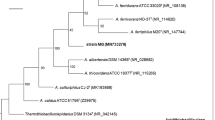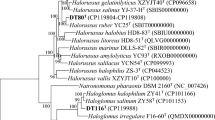Abstract
Thiobacillus halophilus and Thiobacillus hydrothermalis share 98.7% similarity in 16S rRNA sequence, possess similar gross DNA composition (64.2 and 67.4 mol% G+C values, respectively), and have similar physiological properties. While this might have indicated that they were strains of a single species, DNA-DNA hybridization between the type strains of the two species showed only 59% hybridization, indicating the organisms to be different at the species level. Thiobacillus neapolitanus is the phylogenetically nearest neighbour of T. halophilus and T. hydrothermalis (91.6–92.1% similarity in 16S rRNA sequence) and is the only other Thiobacillus in the γ-subclass of the Proteobacteria that can be regarded as exclusively related to these two species. The 16S rRNA gene sequences of these three species are so different from those of the other thiobacilli in the γ-subclass that they justify recognition as a distinct phyletic group. Their comparative properties are summarized.
Similar content being viewed by others
Author information
Authors and Affiliations
Additional information
Received: 23 February 1998 / Accepted: 23 April 1998
Rights and permissions
About this article
Cite this article
Kelly, D., Stackebrandt, E., Burghardt, J. et al. Confirmation that Thiobacillus halophilus and Thiobacillus hydrothermalis are distinct species within the γ-subclass of the Proteobacteria. Arch Microbiol 170, 138–140 (1998). https://doi.org/10.1007/s002030050625
Issue Date:
DOI: https://doi.org/10.1007/s002030050625




